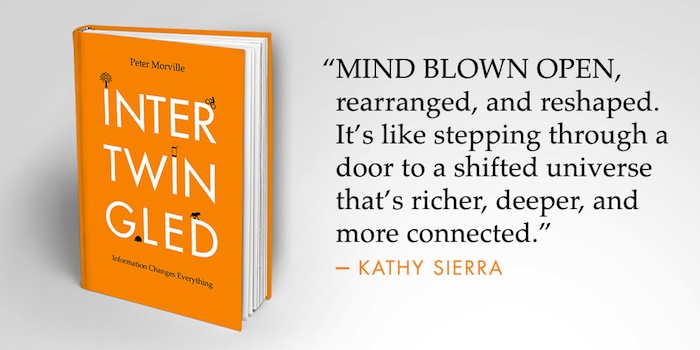Last year, I decided to self-publish Intertwingled. I’ve done the traditional publishing process seven times (counting editions), and for most books I’ve had the good fortune to work with O’Reilly Media. I chose the independent path for several reasons. I wanted the freedom to write outside the boundaries of any category or brand. I wanted to be more involved in design and marketing. And I hoped to earn a larger share of royalties. Now the book’s been out for a month, I’m ready to share my experience and insights.
Strategy
Early on, I adopted KISS. I read Confessions of a Self-Published Author and realized I don’t have as much energy as Scott Berkun. So I reconciled myself to relying on Amazon as my sales platform, using CreateSpace for print-on-demand (paperback) and KDP for Kindle (ebook). This means bookstores won’t carry my book. Libraries simply buy it from Amazon. I didn’t hire an editor. I’m a slow but careful writer, and I’m not bad at copyediting. But I did ask Q LTD to work with me on the interior layout and cover design. I’m super-grateful to Jeffery Callender for making my book beautiful.
Process
I wrote the book in MS Word. It took nine months. I created a back-of-the-book index in MS Word. It took two days. I sketched all the diagrams myself using Omnigraffle and the Noun Project. We did the layout in MS Word, then converted it to a PDF with embedded fonts for submission to CreateSpace. I was eager to publish the book but forced myself to wait a few days for the printed proof. I’m so glad I did, because there was a spinal glitch. There’s a surprising amount of print variance (.125 inches or 3 mm). We modified the spine and back cover and have been pleased with the final result.
Overall, I found the infrastructure for self-publishing to be excellent. The tools are relatively mature and easy to use. When I did have a problem, I received a fast, helpful response from Amazon customer support. And I’m still blown away that within 24 hours of pushing the button, my book was on sale internationally. A customer in Denmark can push a button and have a copy of my book within 48 hours. Amazing!
Promotion
This is tricky ground to cover without a publisher. The advance praise and generous support via social media created an initial splash, but getting the word out remains a struggle. One mistake I made involves pricing. I expected Amazon to discount the paperback by 25% and the ebook by 50% as they do with Don’t Make Me Think and Design for Kids and Search Patterns. But in the absence of competition (publishers prefer to sell directly via their own sites), Amazon doesn’t discount much. This is a major hidden cost of self-publishing. In any case, after a bit of agonizing, I chose to experiment with lower prices. I’m okay earning less per book if I’m able to reach a wider audience.
I’m still working on my plan for promotion. Ironically, I’m reading a book (suggested by Jurgen Appelo) about how to sell your book. I’ll be speaking at more conferences in the coming year. I’ll definitely be blogging. I’ve shared an excerpt and a free chapter. I may try advertising via Google and Twitter. Perhaps I’ll run a contest to have a bit of fun.
That said, if there are things I’m missing, or if you have questions about traditional publishing or self-publishing, let me know. Finally, if you’ve read Intertwingled, please take a moment to write an Amazon customer review. In reality, self-publishing doesn’t exist. A book’s success depends on the contributions of many people, including you.
Conclusion
I wouldn’t recommend self-publishing to everyone. It’s a lot of work. Publishers such as O’Reilly Media and Rosenfeld Media add a great deal of value. Their editors guide authors through the process, and their infrastructure for marketing and distribution is invaluable. But if you’re as entrepreneurial as Abby Covert it may make sense. Taking an independent path to Intertwingled was the right choice for me this time around.
by Peter Morville
